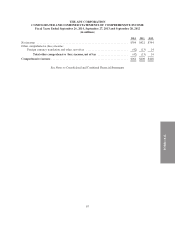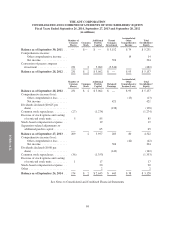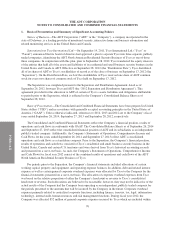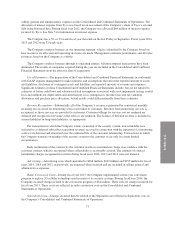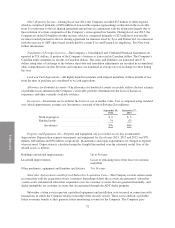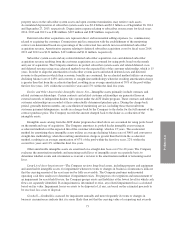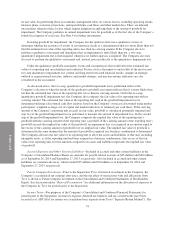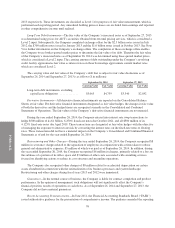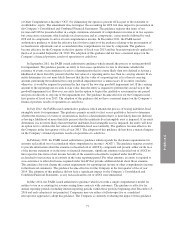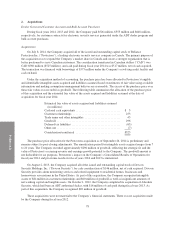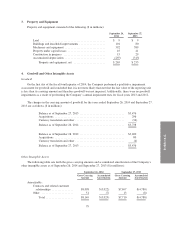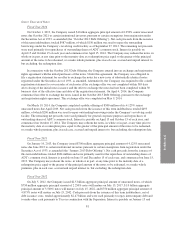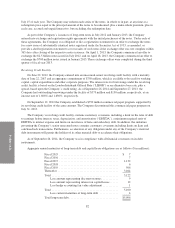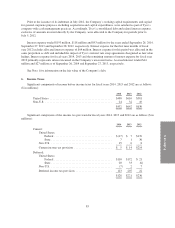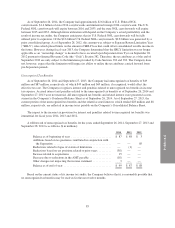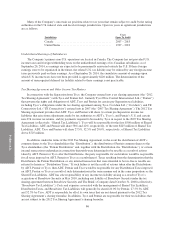ADT 2014 Annual Report Download - page 142
Download and view the complete annual report
Please find page 142 of the 2014 ADT annual report below. You can navigate through the pages in the report by either clicking on the pages listed below, or by using the keyword search tool below to find specific information within the annual report.
FORM 10-K
2013 respectively. These investments are classified as Level 1 for purposes of fair value measurement, which is
performed each reporting period. Any unrealized holding gains or losses are excluded from earnings and reported
in other comprehensive income until realized.
Long-Term Debt Instruments—The fair value of the Company’s unsecured notes as of September 27, 2013
was determined using prices for ADT’s securities obtained from external pricing services, which is considered a
Level 2 input. Subsequently, the Company completed exchange offers for the $2.5 billion notes issued in July
2012, the $700 million notes issued in January 2013 and the $1.0 billion notes issued in October 2013. See Note
5 for further information on the Company’s exchange offers. The completion of these exchange offers enables
the Company to use broker-quoted market prices to determine the fair value of its debt. Therefore the fair value
of the Company’s unsecured notes as of September 26, 2014 was determined using these quoted market prices,
which is considered a Level 2 input. The carrying amount of debt outstanding under the Company’s revolving
credit facility approximates fair value as interest rates on these borrowings approximate current market rates,
which are considered Level 2.
The carrying value and fair value of the Company’s debt that is subject to fair value disclosures as of
September 26, 2014 and September 27, 2013 is as follows ($ in millions):
September 26, 2014 September 27, 2013
Carrying Value Fair Value Carrying Value Fair Value
Long-term debt instruments, excluding
capital lease obligations ............. $5,065 $4,759 $3,340 $2,892
Derivative Instruments—All derivative financial instruments are reported on the Consolidated Balance
Sheets at fair value. For derivative financial instruments designated as fair value hedges, the changes in fair value
of both the derivatives and the hedged items are recognized currently in the Consolidated and Combined
Statements of Operations. The fair values of the Company’s derivative financial instruments are not material.
During the year ended September 26, 2014, the Company entered into interest rate swap transactions to
hedge $500 million of its $1 billion, 6.250% fixed-rate notes due October 2021, and all $500 million of its
4.125% fixed-rate notes due April 2019. These transactions are designated as fair value hedges with the objective
of managing the exposure to interest rate risk by converting the interest rates on the fixed-rate notes to floating
rates. These transactions did not have a material impact on the Company’s Consolidated and Combined Financial
Statements as of and for the year ended September 26, 2014.
Restructuring and Other Charges—During the year ended September 26, 2014, the Company recognized $8
million in severance charges related to the separation of employees in conjunction with actions taken to reduce
general and administrative expenses, $5 million of which was paid as of September 26, 2014. In addition, during
the year ended September 26, 2014, the Company recognized $6 million in charges, primarily related to a loss on
the sublease of a portion of its office space and $3 million of other costs associated with consulting services
focused on identifying actions to reduce its cost structure and streamline operations.
The Company also recognized other charges of $8 million related to accelerated depreciation on certain
assets abandoned in connection with the rationalization of its business processes and system landscape.
Restructuring and other charges during fiscal years 2013 and 2012 were immaterial.
Guarantees—In the normal course of business, the Company is liable for contract completion and product
performance. In the opinion of management, such obligations will not significantly affect the Company’s
financial position, results of operations or cash flows. As of September 26, 2014 and September 27, 2013, the
Company did not have material guarantees.
Recent Accounting Pronouncements—In June 2011, the Financial Accounting Standards Board (“FASB”)
issued authoritative guidance for the presentation of comprehensive income. The guidance amended the reporting
76



